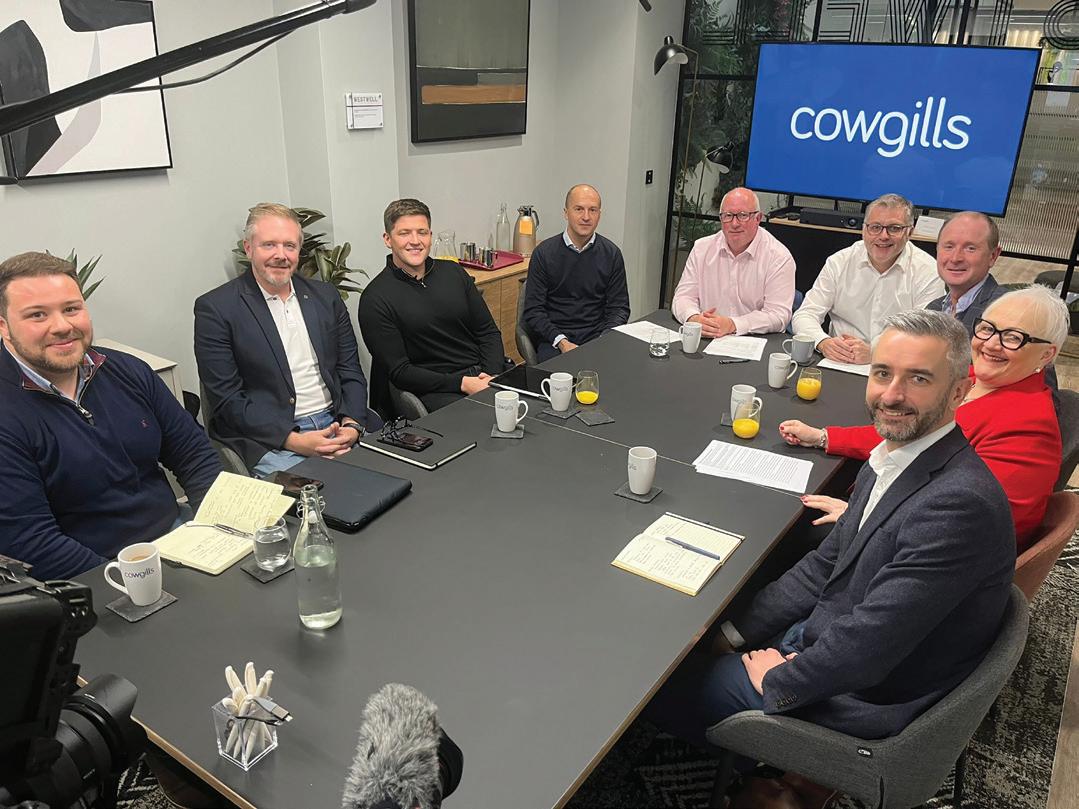Building something special
An SME housebuilder whose approach really adds up
Also in this issue:
Atelier and LDS join forces

Tips for navigating the planning system
Opportunities, challenges and the important role LDS is playing

Issue 04 Spring 2024 www.LDSyoursite.com
owerful
o r
u ilde r s, t h
r
P
knowledge f
SM E houseb
ei
lende r s and finance br o ker s
LDS Team

Kayee Au
PROJECT CO-ORDINATOR kayee@LDSyoursite.com 01204 357813

Mark Hawthorn
CEO
mark@landmark-investments.co.uk 07881 813776

Siobhan O’Donnell
RELATIONSHIP MANAGER siobhan.o’donnell@LDSyoursite.com 07966 940392

Richard Cannings
RELATIONSHIP DIRECTOR richard.cannings@LDSyoursite.com 07875 163906

Ben Jenkinson
MANAGING DIRECTOR ben.jenkinson@LDSyoursite.com 07810 753407

Design, print and production
Blueprint Creative Media
If you’d like to update your LDS Boost subscription preferences, please let us know by emailing boost@LDSyoursite.com

Fiona Connor
RELATIONSHIP MANAGER fiona.connor@LDSyoursite.com 07929 339869

Mark Kilgallon
CHIEF FINANCIAL OFFICER mark.kilgallon@ldsyoursite.com 07540 500 147


Chris Fortune
RELATIONSHIP DIRECTOR chris.fortune@LDSyoursite.com 07865 051814

Alex Maltby
ORIGINATION DIRECTOR alex.maltby@LDSyoursite.com 07775 755983

Darren Reynolds Caron Schreuder
TRANSACTION AND PORTFOLIO DIRECTOR darren.reynolds@LDSyoursite.com 07702 063813
Mark Roberts
RELATIONSHIP DIRECTOR mark.roberts@LDSyoursite.com 07590 434266
PR AND MARKETING CONSULTANT caron@longstoreyshort.com 07903 422325
We are reliably supporting
more new housing and apartment projects alongside more quality senior lending partners. Deeds not words.
Welcome to the Spring issue of LDS Boost, providing powerful knowledge for housebuilders, their lenders and finance brokers.
While there has been renewed optimism in the early part of 2024, I’m cautious—particularly given the thinly disguised incentives of most commentators. It still seems a very tough and uncertain market to me.
What is certain is that not enough homes are being built, and the housing shortage is worsening with every year that supply doesn’t grow in line with demand. LDS was created to help SME developers and their lenders fix this problem and we’re proud that our Sales Guarantee is now an established part of the development capital stack. We are reliably supporting more new housing and apartment projects (large and small) alongside more top-quality senior lending partners. Deeds not words.
In a tough market, quality relationships are essential, and we’re proud to showcase two great ones in this issue.
First up, Martin Gilsenan, Chief Originations Officer at our newest senior lending partner, Atelier. Our conversation
was extensive, and I was struck by how hard Martin and team are working to build their business; they’re hungry to lend and have plenty of stable capital to deploy.
Our cover story features Joe and Matt from PPJ Developments. In partnership with West One, we’re supporting PPJ to develop a £5.5m GDV site in Gomersal. It’s going (very) well and this project is clearly just the introduction to a compelling growth story.
We also hear in depth from Alex Maltby and Richard Cannings. They have lots in common: both formerly of the RBS parish, both based in the southwest, and both now leading the LDS origination charge across England and Wales. Despite being only three months into the role, Rich hits the nail on the head with his comment: “First and foremost, ours is a product that gets deals over the line.”
We’re on our travels in March, dropping anchor in Cannes for MIPIM before hitting Leeds in May for UK REIIF. Both are important industry events and my sense

is that the latter, which is already huge, will assume increasing prominence in future. We’ve also got a big night planned on 20th June, hosting a private screening of England versus Denmark in Euro 2024.
As always, do let us have any feedback on the issue. We’d love to hear from you.

ben.jenkinson@LDSyoursite.com
07810 753407
01
Ben Jenkinson, Managing Director
“ We want Atelier to be a byword for certainty–we deliver what we say we will ”

LDS has joined forces with development finance lender Atelier to create a partnership that supports SME developers and housebuilders.
Atelier has been trailblazing since its launch in December 2019, so this is an exciting collaboration—both businesses are firmly aligned in their aim of innovating to help drive the delivery of new homes.
But who are Atelier and how do they differentiate themselves in today’s competitive funding market? We spoke to Martin, Chief Originations Officer, to discuss this and more.
How did it all start?
Atelier is a joint venture between the senior management team and M&G Investments. Three months after the business launched, Covid hit—and this created an opportunity for Atelier, which
saw its team filling the spaces where some established lenders no longer wanted (or were able) to lend. This vacuum created room for a new lender that would do what it promised. We felt that the market was ready for a challenger to the challenger banks.
By offering certainty of delivery, we won a lot of business and secured relationships. Most of the business we wrote in 2020 was bridging and refurbishment, but it was always Atelier’s goal to become a development lender—it’s in our DNA.
We felt it was time to offer the market a different model for serving brokers and developers. This entailed providing certainty much earlier in the credit process.
02

We have always looked to provide a collaborative approach, and we have found this with LDS
Who makes up the team, and what does deal origination look like at Atelier?
The Senior Management Team comprises Chris Gardner, CEO; Paul Silva, CFO; Alan MacLeod, Director of Credit; Rebecca Nutt, Head of Development Monitoring; John Fox, General Counsel; and myself as Chief Originations Officer.
When I took on responsibility for the originations function, it was very important to me to foster a joined-up relationship between the sales and credit parts of the business. Not only is this critical to our success, it also differentiates us from other lenders.
Essentially, our originations team needs to have a ‘head’ for credit, and credit need to provide quick responses wherever possible to support new enquiries. This interaction is reflected in our approach to indicative term sheets, as we only send
these for deals we want to fund—those that we’re confident about supporting.
We’re committed to lending across the country, and our originations model supports this. Our central team is based in our office in Fitzrovia, and this is supported by a permanent regional presence, with lending managers in Bristol, Birmingham and Edinburgh. These experienced ‘boots on the ground’ mean we can deliver a better service due to local insight and experience.
What sort of attributes do you look for when hiring?
The main requirement is that the candidate is aligned with the culture of the business and possesses a team ethic. It’s a misconception that sales teams need to be cutthroat and compete against each other.
On top of understanding the market
and having the requisite skill set, being collaborative and prioritising the right internal team-based outcomes are just as vital as being able to communicate with brokers and developers.
Although a certain amount of tension is healthy in a business, Atelier places great importance on everyone buying into and agreeing on its appetite for risk. This has been embraced by the team and adds a different dimension to their working day.
What has your experience been like in bringing a new lender to market?
The Atelier brief was clear: get the brand to stand out in a very crowded industry— there are approximately 400 lenders operating in the space currently, so the need to differentiate and stand out is important.
We want Atelier to be a byword for certainty–we deliver what we say we
03

04
will. Within our network of intermediaries and professional SME housebuilders, we feel that our clarity and consistency in communicating this message is paying off, helping us become trusted both as a brand and a business.
From a marketing POV, the job is made much easier when the service you’re offering stands up to its claims—and ours does.
In October 2021 Atelier pioneered the Carbonlite Challenge, an initiative designed with the Royal Institute of British Architects (RIBA) to encourage the building of greener homes. What’s the latest on this?
It was important for us to do something positive and to break new ground within sustainable development finance. Carbonlite is a truly innovative financial solution offering incentivised finance for greener homes—connecting smarter, cleaner capital with the most ambitious low-carbon residential property developers. It was a pilot that showed the market what was possible and the role that SME developers could play in sustainable development.
We’ve completed some excellent schemes through Carbonlite, all of which are on track.
The £25m pilot has been fully allocated, proving that the market for it exists. Conversations are now underway about what stage two looks like.
What do you think lies in store for the market this year?
confidence—and confidence drives the housing market. The return of some form of Help to Buy pre- or post-election is likely; ultimately how ‘good’ that is for the market remains to be seen, but it will surely stimulate activity at entry level.
“ It’s no use us, and senior lenders in general, tapping out at their lending limit and making no effort to find solutions for developers at the equity level ”
Finally, what are Atelier’s ambitions for the next 12 months, and what are the prime opportunities for you?
We have a very straightforward business plan, which is to grow our AUM to £500 million by March 25th 2025, and we have both the funding capacity and appetite to achieve that.
Residential C3 is what underpins our business and remains our core market. In addition, PBSA, PRS and Care are sectors that were good for us in 2023, so we will continue to support favourable opportunities in these asset classes.
2023 saw many people affected by rising interest rates. This, coupled with the increase in costs and materials, caused a lot of stress in the market. We believe that the first half of 2024 will be challenging for developers and lenders alike.
The biggest hit to developers has been the collapse of the first-time buyer market. This has been caused by the difficulty in obtaining and servicing a mortgage in a higher interest rate climate. This has led to an erosion in
It is widely considered that interest rates will be cut in the latter half of the year. With the new normal anticipated to be around 3.5%–4%, we are confident that a reduction in interest rates will help stimulate pent-up demand and we are actively looking to support residential development schemes that have sales coming to market in 2025/26.
What drove your decision to partner with LDS?
It was not lost on us that LDS maintained (and even refined) its junior funding position and appetite in 2023. This was a time when both mezzanine finance and investor appetite for JV equity were in retreat. It was uppermost in our minds that LDS is bringing much-needed liquidity at the top of the capital stack, where stress levels were high and delivery levels low.
It’s no use us, and senior lenders in general, tapping out at their lending limit and making no effort to find solutions for developers at the equity level. We have always looked to provide a collaborative approach, and we have found this with LDS.
Our businesses have a very similar approach to what constitutes a good deal, which will be the catalyst to writing business together successfully.
Looking further into the future, our aspiration is to continue to grow. However, this isn’t a market for overreach, whether that is a race to scale, or offering the wrong products. We’re interested in sustainable growth and a strong performing loan book.
Project characteristics
Location
Liquid location, with good comparables
Experience
Solid experience in delivering similar schemes in the region
Product
Mainstream product suitable for the location and market
Recourse
Financial alignment, PG or CG, supported with strong A&L
Construction
Build costs at market rates, robust procurement route
Exit
Plausible exit strategy, with a plan A and plan B
To get in contact with Martin, call 020 7846 0000 or email enquiries@atelierfinance.co.uk
05

Building something special
An SME housebuilder whose approach really adds up




















Joe Carter and Matt Reynolds, joint Directors of PPJ Developments, are numbers guys. Their meticulous crunching of figures and planning has led to the successful delivery of their debut project as partners, supported by LDS and senior lender West One, with several others in the pipeline.
In this interview, we discuss margins, scaling an SME housebuilder, and the importance of control, among other interesting elements of the business. If PPJ’s ambitious outlook is representative of the future of residential development, it certainly seems bright.
06
Joe Carter
Matt Reynolds
How did you come together to form PPJ?
JC: My dad was in property, so I grew up being exposed to the industry. When I was 18, I embarked on my first development and got a proper taste for it—I was inspired. One renovation led to another, with the jobs getting bigger, but there are only so many times you can take a rubbish house and turn it into a nice one. I wanted to do more.
Matt and I had known each other for a couple of years at that stage and we were always talking about possible business ventures. One day, we met up in Starbucks and seriously looked at some figures–within 30 minutes, we were viewing a hotel conversion together. Two months later, we had our first plot of land.
MR: For about a decade, I’d worked on a few smaller renovation projects and newbuild apartments, but had amassed quite a bit of business experience and was clued up when it came to finance and leveraging. My ability to use debt to scale coupled with Joe’s practical expertise was the blend of skills needed for us really to make a go of it.
What makes a PPJ scheme stand out?
MR: From the outset, we have been committed to delivering a high-quality product, with a particular focus on eco-friendly measures that will result in the low-cost running of our homes. We went over and above with insulation, underfloor heating and air source heating pumps—aspects that cost us a lot but are attractive to buyers for the long-term benefits.
JC: In comparison to other sites in the area, we feel we’ve created a product that is truly high spec. There is attention to detail in the materials used and how they are sourced, and in the provision and quality of the features.
“ It has been key for us not to become waylaid by the negativity over the past few years. You must work with what you’ve got and adapt; accordingly, we created incentives and adjusted our prices to get sales through ”
Over the course of this project, Copper Beech View, what changes have you experienced in the sector?
JC: We’ve always been conscious of the importance of maintaining a healthy profit margin in order to minimise the effect of a massively fluctuating market. Our margin is set to 25% for this reason, and that has provided comfort when the unforeseeable has hit, like the interest rate hikes.
It has been key for us not to become waylaid by negativity over the past few years. You must work with what you’ve got and adapt; accordingly, we created incentives and adjusted our prices to get sales through.
MR: We were hit from both sides: interest rates shot up and sales activity slowed. But we acted quickly. You can get in a bit of a mess if you’re stubborn when it comes to target prices or get emotionally attached; you have to be dynamic and fluid in line with the market.
JC: I believe that if you have managed to be successful in the past 12 months, you can be successful in any market condition.
In hindsight, given what’s happened to the market, we may have thought twice about certain expensive elements and the desirability attached to those, but we have no regrets. Coming back to margin tolerances, these allowed us to pull off our business plan in full.
Given that many of the challenges facing developers were known at the time of embarking on your first project together, how did this affect your approach?
MR: Having things like labour and materials shortages already present in the market did lead us to spend more time on research and preparation, and we built our tolerances around those obstacles. We were well positioned to weather the unknown.
JC: And the biggest unknown was the ferocity with which the base rate increased. When you’re leveraged and in for millions of pounds, every half a percent has a huge impact—and it just kept coming. The meticulous nature of our plan ensured it was a relatively smooth experience.
What do you have lined up for the next two to five years?
JC: We have three projects in the works over the next five years. The first is for a site of 15 homes that is pretty similar to Copper Beech View.
Then, we are working on a social housing site—a significant departure from what we’ve just built. This will be in partnership with Kirklees Council to assist with their delivery targets for the area.
07
The next big step for us is a scheme of between 30 and 35 units, which will be another high-end product. We’re in the process of deciding on the house types now and are likely to commence in about 18 months. This will be considered our flagship site.
MR: We also have plans to take over the contracting and project management of future projects ourselves. This has several advantages, the primary ones being a better level of control over quality and standards, and a reduction in costs.
What is your scaling strategy?
MR: We could keep things quite steady by sticking to sites of the same size and price, but that won’t equate to growth for us. We’re after the sense of achievement that comes from bettering what we’ve done previously.
“ We are reinvesting everything we make into future projects, with the view to this compounding into something really special ”
JC: We are reinvesting everything we make into future projects, with the view to this compounding into something really special.

Do you feel supported in your growth by lenders, government iniatives and other players?
MR: Track record matters, so naturally those who’ve completed projects for 20 years are going to have money thrown at them. But everyone has to start somewhere, so as long as the numbers stack up and you’ve done your due diligence and you can display that to lenders, they’ll be comfortable. You also create your own luck by securing land—it’s everywhere if you’re proactive about finding it…
JC: It would be great to see more support for green-led technologies in property development. There’s nothing available in terms of grants and very little incentive for developers to introduce greener elements—such as solar energy—into their projects.
Would you say that PPJ has a niche?
JC: You’ve got three kinds of developers: self-builders with one or two units; big outfits who won’t do less than, say, 30; and then a much smaller group with mediumsized developments comprised of about nine or 10 units. This middle ground was seemingly being ignored by many developers but we see the potential, so this is where we have situated ourselves.
And just because we are heading into a larger volume scheme, we are fully open to opportunities in our original niche as we see it as a great business model.
MR: As part of our plan to take over the contracting, the savings made—in both time and cost—will also contribute to our ability to go after larger opportunities.
Tell us about your introduction to and experience with LDS so far
JC: A broker reached out to us on LinkedIn and spoke about ‘topping up’ our funding using LDS. Among all the jargon going on, we took our notes and simply jotted down LDS as another abbreviation. When we sat down to discuss our options properly, the LDS proposition became clear, and we introduced the idea to our senior lender, West One. Funnily enough, the lender and LDS ended up doing deals before we even signed up and got things moving!

When you’re relatively new, LDS gives you a leg up—the chance to go further. With their support and capital top-up, we did nine homes rather than five. It costs a bit more, but you make more, too. It’s undoubtedly a fantastically clever business model.
We’ve been surprised by how down to earth the team is. Our relationship with Mark Roberts has felt fair and communicative, and he’s always ringing up to see how we’re doing.
Finance is always serious business, but with LDS, it’s refreshingly unpressurised.
08




LDS gives you a leg up—the chance to go further. With their support and capital top-up, we did nine homes rather than five. It costs a bit more, but you make more, too. It’s undoubtedly a fantastically clever business model.
09


Providing confidence and capacity
Amid the spirit of optimism that abounds in Q1, we spoke to Alex Maltby, Origination Director at LDS, and Richard Cannings, Relationship Director, about their expectations for 2024 and what they believe to be the primary opportunities for developers and finance brokers in the months ahead.
For the first time in a while, we do not appear to have begun the year under a cloud of complete uncertainty. Destabilising factors are still present, but many of them are already relatively familiar to those working in property, and there is a sense of going into the year with more awareness of what might be to come. The positive sentiment around forward interest rates and inflation growth softening are two very welcome trends.
“We have an important role to play in alleviating pressure—as a source of both growth capital and risk removal”
For both Alex and Richard, their sights are set on supporting SME developers so that this can be a favourable period for housing activity.
Reflecting on 2023, the word ‘resilience’ comes to mind for Alex—particularly in relation to house prices and employment. “It’s something of a pleasant surprise. If you consider the number of challenges the macro economy has presented to businesses and consumers, and obviously the property industry, it has been stark.”
He is, of course, referring to inflation reaching its highest rate for 40 years in 2022, and the base rate rising from 0.1% in December 2021 to its current level of 5.25% (as of February 2024). On top of soaring funding costs, labour shortages and material supply issues, the tepid sales market has proven difficult for SME
developers and housebuilders.
“In a higher interest rate environment, time is the enemy of equity,” Alex expands. “As the sales market has slowed and the planning system remains stuck, a lot of developers are under pressure, having to rely on their existing capital bases to be able to trade, and are really stretched. This inevitably has an impact upon future activity.
“We have an important role to play in alleviating some of this pressure—as a source of both growth capital and risk removal.”
LDS has been working with plenty of developer clients for whom equity is constrained and an injection of cash is needed. Richard states that, to date, there has been a lack of innovation within the development finance market,
10
Richard Cannings Relationship Director, LDS
Alex Maltby Origination Director, LDS
specifically where developers require higher leverage. The LDS capital advance is a welcome proposition,, as it is free of the compounding interest and upfront fees associated with other junior funding options.
“At this stage in the property cycle, we often see SMEs thrive when they focus on their local markets. The current conditions provide a wealth of opportunity for developers to use their regional experience to make projects work.”
He believes that there has been a propensity for would-be home purchasers to delay moving, pending a reduction in market volatility; this is evident in the slow sales rates on many completed sites. However, many people have now been holding out for some time, and as life continues, more event-driven home movers are starting to enter the market, such as those with growing families and the need to be closer to schools.
Richard also expects to see an increase in first-time buyers that had previously been considered part of ‘Generation Rent’. “With rental growth at a record high, and difficulties even securing viewings, potential first-time buyers are willing to make far greater sacrifices to save for a deposit. Combined with reducing mortgage rates, that will drive this market.”
“I think we will see purchasers of new builds being more discerning,” Alex shares. “In some locations, there is an oversupply of completed housing stock— and this is where SMEs have the edge over volume house builders when it comes to creating homes that fulfil a certain type of would-be homeowner’s dream.”
about making that step of moving out of the city-centre apartment into everyday suburban life.”
them in a low-volume environment? Both agree that now is the time for deepening relationships. “Successful brokers will probably be looking at their trusted pool of lenders, and looking to provide developers with the lowest execution risk as they manage the multiple processes required to get construction underway,” Richard says.
“ At this stage in the property cycle, we often see SMEs thrive when they focus on their local markets. The current conditions provide a wealth of opportunity for developers to use their regional experience to make projects work ”
He posits that, when it comes to choosing a home, a variety of buyer tastes need to be satisfied—and smaller developers are bringing optionality to the table. “SME housebuilders are especially good at delivering quality homes that are in keeping with the character of the area they’re in, complete with modern tech, sustainability and amenities.”
Alex considers the General Election and the impact this may have on the housing market. “Many of the developers we speak to feel that additional first-time buyer support to get on the housing ladder is vital, and will significantly boost demand and supply-side sentiment if included within the manifesto of the next government. An election itself can be a cause for uncertainty so we’ll be paying close attention to the policy announcements of the main parties in the coming months. LDS, like the rest of the development industry, has high expectations from the next government
“ In the junior funding market, it’s far more disparate and opaque in terms of pricing and availability of funding. LDS is changing this—instilling a greater degree of confidence, capacity and consistency in this space ”
Richard agrees. “National housebuilders tend to focus on efficiency with tried-and-tested unit types, and that certainly benefits the wider remit to build a greater number of houses in the UK. But these don’t appeal to everyone, let alone excite people
to get a handle on the challenges in the planning system once and for all.”
Turning our attention to development finance brokers, what is expected from
”Although we are experiencing an increased volume of business, it is equally important for us to strengthen our relationships with quality brokers, lenders and developers,” Alex affirms. “With fewer opportunities around and many headwinds that can put deals off course, it is vital to have trust and confidence between partners.”
Over the last 12-18 months, huge emphasis has been placed on certainty of execution over other concerns such as pricing. Given that the senior debt market is regarded as largely homogenous, actual delivery is often the core differentiating factor. “Brokers now know who they’ve got a much better chance of executing with, particularly within the senior funding market,” Alex comments.
“In the junior funding market, it’s far more disparate and opaque in terms of pricing and availability of funding. LDS is changing this—instilling a greater degree of confidence, capacity and consistency in this space”.
“LDS provides comfort to senior lenders’ underwriting teams,” Richard concludes, “because we offer an alternative exit option. This mitigates one of the major hurdles for credit committees, thereby improving the chances of the deal getting through—which is ultimately what matters. First and foremost, ours is a product that gets deals over the line.”
11
The best laid plans
Is planning in fact getting more cumbersome, and what can SMEs do to successfully navigate the process and keep building?
12
Despite changes to the framework, the one-size-fits-all system has ultimately ended up fitting very few, but as Patrick Reedman says: “Business is done in the here and now; SMEs can’t hold back and wait on reform that may never come.”
We enlisted the views of two planning consultants to hear what they have to say about the system–and the prospects for SME developers eager to grow and build more new homes.
13
Patrick Reedman
Director at DHA Planning
17 years’ planning experience
Half of DHA’s clients are SMEs

The planning system is increasingly likely to fail you if you’re not properly informed.
Despite promises of changes that will streamline the planning process, ‘reform’ has so far mostly served to make things more expensive, overly protracted and, crucially, less predictable for applicants. As things stand, and despite the government’s promises to the contrary, current suggestions for policy reform will also have the alarming effect of putting the brakes on housing delivery in certain areas.
In an environment of constant changes in legislation and policy direction, it is unsurprising that many applicants simply lose the will. It is this increased uncertainty in the system that is perhaps the most concerning issue for SME developers and applicants—not to mention new requirements that are regularly dropped on them, and which can significantly affect the course of the planning journey.
It has always been the case that delays abound in planning—that is an unhappy truth that is almost universally accepted by developers. However, it is the difficulty of finding ‘certainty’ in the system that constitutes the latest worrying trend.
Take, for example, the matters of river pollution, nutrient loading and water neutrality, which are presently holding up many thousands of new homes in the planning system. Promises of effective legislation to deal with the problem have largely failed, guidance from Natural England is regularly changed and updated, and local authorities are naturally cautious about committing resources to finding their own solutions (which will mostly require significant land and/or financial commitment).
This leaves large parts of the country, such as East Kent, without a clear solution that would unlock much needed development. Moreover, these sorts of issues, which are not effectively tackled at central government level, disproportionately affect SME-scale developers who do not have access to large landholdings on which to provide their own mitigation.
Essentially, there are two sides to the current uncertainty and complexity within the planning process: the technical and the political. The first deals with aspects like flood risk and checkboxes that can and should be prepared for; the latter is more difficult to control and predict, and is a major part of the process that should not be underestimated—housebuilders of
all sizes need a strategy for dealing with it.
For SMEs, their sites can attract specific planning problems. For example, blanket Biodiversity Net Gain (BNG) requirements on smaller projects—often more easily mitigated on larger sites—make it trickier to incorporate the necessary measures, and paying for off-site mitigation will be disproportionately more expensive, adding pressure to what are already thin margins. These things hit an SME developer’s bottom line—and, as aspects such as BNG are statutory requirements, in many instances they will reduce the viability of providing other planning benefits such as affordable housing.
Can the pre-application process help reduce uncertainty for the SME developer? Well, yes—in most cases pre-application engagement with the local authority is a beneficial step that can improve the quality of a subsequent application and give it a more predictable outcome. However, you need to have good and experienced staff at the council to provide the advice, and SMEs can be disadvantaged when their site isn’t quite big enough to warrant an expensive planning performance agreement process (an informal contract between a consultant, the client and the council ahead of the official application), resulting in the application being relegated in favour of those who can afford this dedicated department resource.
SMEs may end up with a less experienced officer and/or poorer service, and these are particularly detrimental when handling complex issues such as heritage and viability, which are often inherent with smaller sites. This is further compounded by the fact that planning departments are underfunded and underresourced, leaving them scarcely able to retain the necessary expertise to uphold standards, let alone speed things up.
Accepting the complexities of the planning process, a large part of our role as planning consultants lies in understanding the nuances of local planning authorities and bringing the right people on side from day one.
14
Council and committee priorities differ across boroughs (and often even within different parts of a borough), and no two planning authorities are the same. Where one planning authority might have a particular focus on achieving ‘beauty’ in design (another recent intangible planning requirement!), other boroughs concentrate on the provision of affordable housing at a political level above all else. There are several questions to be considered for each project: is the authority particularly underfunded? Does it have a vocal residents’ group that could be an obstacle? Is it as simple as knowing that the committee opposes the use of a particular type of brick on the outside of a building? In planning, time equals money—so it pays to be properly informed from the point of conception of the project. That is where the skill of a good planning consultant comes in.
Local consultation will always have a part to play in any meaningful planning strategy. For as long as planning exists, it is right that it remains a democratic process at its heart because it is about finding ways in which the rights of developers and landowners can be exercised in the public interest. The key to an effective pre-application engagement strategy is, however, making sure that a balance of voices are heard. Typically the voices of the ‘YIMBYs’ (‘Yes in My Back Yard!’)—the people that want and need development to exist—are much more difficult to hear than those of the ‘NIMBYs’ who will dominate the narrative if engagement is not properly handled. Moreover, planning at all scales is about developing for an area, so understanding the higher-level political ambitions within a particular ward, borough or region is central to a successful outcome. Using our relationships, we will always try to work with, rather than against, the planners, politicians and stakeholders. There’s no such thing as a carbon-copy approach to doing development—that’s why our job is an art, rather than a science.
The most importance bit of advice I can impart to SME developers is to engage
with a planning professional early on, when the project is first conceived. Too often, we are contacted after a developer has purchased a site and got an architect involved, before proper consideration of the planning implications that could make or break the ultimate product— both on the technical ‘compliance’ front (e.g. the technical requirements of the plan in terms of issues like accessibility or parking) and also in terms of the groundwork required to understand the politics of a particular location and borough. Addressing these issues from the outset would have saved a great deal of time, saved wasted expense, and led to a successful outcome.
The value of effective and meaningful presubmission consultation is immense. Why wait until the application gets to planning committee to find out whether the key decision makers are on side or not?
And what about the future of planning? My perspective on the prospect of real positive change in the system lies in a shift in mindset, starting at government level.
Decisions need to be made that drive growth. For example, are we unnecessarily preserving the green belt in aspic? Does a planning authority have to be involved in signing off every home that needs building? Would some sort of zoning reform (and nobody has heard the ‘Z’ word in planning since Boris!) actually aid SME developments?
The most recent national policy reforms have increased, not reduced, the ability of planning authorities (particularly those around the edges of London and other big cities) to decide to provide less housing than they actually need to meet needs. Why would a green-belt authority in Kent or Surrey want to build on its green fields when it doesn’t have to, and it certainly won’t win votes?
The result will be a reduction in the number of homes being built where they are most needed—in unaffordable areas. There is no political impetus for the current government to do anything about it (in fact, it’s more like the opposite), but
in an ideal world, what needs to happen is:
1. A return to some sort of centralised or regional approach to planning for housing, where housing delivery was co-ordinated and couldn’t be dodged by the districts and boroughs for political reason;
2. A full and comprehensive review of the green belt. There are towns and larger settlements in the green belt that would be highly sustainable places to build; places within, say, half an hour’s train ride of the city centre, which are unused because of policies from 70 years ago. Instead, commuters and housing are leapfrogging these areas, increasing reliance on cars and driving down quality of life. Planning reform should require development of green belt land (brown and greenfield) which would provide for sustainable growth, where residents have access to shops and services and can rely on noncar transport to reach their places of work.
Originally, planning was a process of control; nowadays, it needs to be a partnership between authorities and SME developers and landowners, proactively working together to find solutions to unlock sites and deliver much-needed housing.



15
 David Kemp Director at DRK Planning
David Kemp Director at DRK Planning
25 years in the business
Mostly SME developer client base
The planning system is a bureaucratic one with a large number of stakeholders involved, which makes it susceptible to sluggishness. This is not going to change. However, with adequate due diligence, buying at the right price, and having several exit strategies ready to be deployed, the process is navigable.
As well as taking a commercial and practical approach to planning challenges, DRK Planning will consider a risk-sharing fee arrangement on appropriate projects. The firm also participates directly with partners and associates in some development opportunities.
Developers are very good at having an instinct for sussing out an opportunity. There are those that have made clever purchases at the right price and in the right areas, got planning permission and come out at the other end with a quality product.
On the topic of exits, developers need to be nimble to stay in the game. For instance, you may have a smaller scheme for which planning is easier to obtain, adding value to the site. By refinancing that loan at a higher value because of the uplift, you’ve now got some headroom whilst seeking to optimise the site further.
Delays in applications often cannot be avoided—but we have learnt several things along the way that may help.
When any planning application goes in, it requires monitoring and chasing. The job is only ever ‘half done’ just by submitting the application. Applicants need to chase up registration, and then validation of the application, to ensure that it is properly ‘in the system’ and travelling through the various stages.
Tenacity in chasing up applications through the process is key. Make sure that you are clear with your consultancy team that this will be done and when it will be done. Wires can easily be crossed between client and consultant, resulting in an application left to linger.
“ The earlier you engage with ward councillors about your intentions, the better an understanding you can get about resident and local political sentiment ”
There is a friction that exists between the government and local authorities–this is fuelled by conflicting priorities, and as planners, consultants, developers and investors, we can’t control any of that. But what we can do is work with the situation in front of us.
Think well in advance of all professional reports required. All consultancies are busy and, wherever possible, people’s time needs to be booked in, not left to the last minute. Transport surveys can only
16
be done during term times at least one week clear of the start or end of school holidays, and bat surveys and some other ecological reports must be conducted between May and September.
Don’t be afraid to go ‘up the chain’ to team leaders and then to Heads of Service, or finally to Executive Directors, Councillors, Portfolio Members for Planning or Leaders of the Council. A delicate balance needs to be struck in doing this so as not to jeopardise the relationship with officers.
Knowing when and how to push officers, or complain to Councillors, is difficult and extremely subjective. Discuss this with your professional team, utilising the inherent relationships with the Council within the team and contacts made through any prior informal consultation at the local level.
Pre-application processes can divide opinion and exclude some schemes on the basis of size and cost, but bringing planning officers in at the very outset shows respect for their position and gives you a good chance of buyin. You’ve got to have active dialogue because, ultimately, this is a negotiation. The crossover between what a good development looks like to them and what it looks like to you is the sweet spot where permission is granted.
It is recommended that public consultations are held, after meeting with an officer to determine the broad boundaries for input. Often, the local community object to plans simply because they feel disenfranchised in the process; the goal is to minimise this to avoid having to go to planning committee, at which stage things become far more uncertain.
The earlier you engage with ward councillors about your intentions, the better an understanding you can get about resident and local political sentiment. This may add some time leading into the project, but can result in less local objection.
Because planning can be such an elongated process, re-evaluating
constantly is imperative. Values, costs, and policies can all change during the process, so you want to start with the very best information available.
As well as engaging early with a planning professional, managing investor expectations is extremely important.
Share exit plans A, B and C with them; problems creep into these relationships when there is a lack of transparency around preparation.
In terms of reform, it’s imperative that local authorities feel valued and properly funded if we’re to retain and recruit the best people for the job. Chronic underresourcing has plagued the profession for ages, and with each year that not enough money is pumped into it, experienced people are lost from local authorities and not replaced quickly enough, which can affect the quality of decision making.
An election will see some of the changes that have been approved as part of the Levelling Up and Regeneration Act, but which are currently in a holding pattern— such as infrastructure levy, street votes and community land actions—come into force.
What it boils down to at present is that developers often need to run two sets of numbers: one based on everything that’s advertised coming to fruition (stabilised fluctuation and interest rates, the roll-out of positive policy changes, a government that prioritises delivery); and another that assumes the worst-case scenario. This ‘sensitivity analysis’, or stress-testing, of the viability of the project is key to good due diligence and can ensure a balance between a realistic and a competitive bid for land.
At a glance
• Engage early with a planning professional—time equals money, and it pays to be properly informed from the point of conception of a project (even pre-purchase)
• There are two sides to planning: the technical and the political. The former is mostly check-boxes you can plan for; the latter is more uncertain, and a strategy is required to successfully deal with it
• No two planning applications are the same, largely because no two local authorities have identical priorities when it comes to building in their boroughs
• Pre-application engagement with the local authority can improve the outcome of the subsequent formal process— understanding the local politics and bringing key stakeholders on side early on can save time and money
• Objectors (or NIMBYs) are far ‘louder’ than those who want development to take place in their areas—an effective application needs a balance of voices to be heard. Involving the local community through public consultations ensures that they don’t feel disenfranchised and therefore more likely to object
• Staying on top of the progress of your application is important; follow it up diligently to avoid unnecessary delays in it moving through the system
• For some reports and surveys, timing is vital – book in the required professional services well in advance to ensure it’s locked in
• Escalating matters in relation to decisions or delays is a delicate operation and where the relationships held by consultants can come in particularly handy
• Statutory Biodiversity Net Gain (BNG) requirements are not as easily mitigated on smaller sites and can disproportionately impact SMEs’ projects

• Keep your exit options open, paying mind to changes to value, costs and policies throughout the project; it’s advisable to prepare for more than one outcome, and to have a plan A, B and C ready to deploy, especially in the present economic and political environment
17
LDS News
LDS returns to MIPIM
It’s almost time for the annual gathering of real estate professionals on the Côte D’Azur, and the LDS team will be out in force.
From 12th to 15th March, MIPIM turns Cannes into a hotbed of property activity, bringing together developers, investors, lenders, finance brokers and every industry provider in between.
Mark Hawthorn, CEO; Ben Jenkinson, Managing Director; Alex Maltby, Origination Director; and Relationship
Directors Mark Roberts and Richard Cannings will be in attendance and look forward to meeting up with many of our partners during this busy week.
The LDS boat will be moored in the Old Port, close to all the action. We’d love to welcome you on board for a drink and a catch-up, and to hear all about your project plans in the coming months.
On Wednesday, LDS is once again hosting its annual boules tournament in partnership with Gunnercooke and Watts Commercial Finance—the ideal open-air
opportunity to inject a bit of competition into proceedings.
We’ll also be hosting a very special lunch at Tom Bloxham’s iconic Maison Blue mansion.
Please get in touch to book in a time to get together by emailing boost@LDSyoursite.com

Mark Kilgallon joins as CFO

We’ve appointed former Fluent Money Group Financial Director Mark Kilgallon as CFO.
Mark has an impressive career in leadership roles across a variety of successful financial services companies, and brings a wealth of experience to LDS.
“I’m a believer in the product and the people at LDS; the opportunity is clear, and the market is rapidly adopting it,” Mark says.
“The potential is enormous, and the
product is superb. LDS is perfectly positioned to unlock additional housing supply by supporting housebuilders with funding and senior lenders with risk removal.
“The team ended 2023 with record numbers and 2024 has started in the same vein. I’m looking forward to being part of the journey and success.”
LDS presents at the HBF Development Finance seminar
Alex Maltby and Ben Jenkinson joined an esteemed roster of speakers at the HBF’s seminar for SME developers, including representatives from Close Brothers, LendInvest, UTB, and Homes England.
Attendees heard from a cross-section of finance providers, all of whom are keen to support growing SMEs and the delivery of new homes.
Alex said: “It was great to meet with a variety of developers and run through the
LDS proposition. Over coffee we received some great feedback on our approach and some interesting perspectives on the challenges being faced by SMEs.”
Ben added: “There was a genuine sense of positivity among member developers, all looking forward to 2024 with determination to get on and build–which matches our committment to unlocking more new homes.”
19
LDS News






20
Out and about
Pivot X LDS Festive Drinks
West One X LDS Networking Event
Finance Professional Show 2024
Cowgills Roundtable
North West PROPS Awards
Bristol Property Awards





Philip Jones, of Tang Developments, said: “With the support of LDS, we have been able to unlock the potential of two sites and reduce our sales risk.
“The LDS deposit topped up our senior debt with West One and proved crucial in progressing both locations.
“We’ve found dealing with LDS seamless and their offering much needed—especially in the present funding market—and we look forward to the potential of working together on more projects.”
Speaking on behalf of the developer, Stuart Gaiger, Shareholder Director of The PG Group, said:
“We’re delighted to conclude this first transaction with LDS. Not only will this speed up the completion of this project, but it also supports us bringing forward our wider pipeline of homes throughout the southwest.”
LDS and West One unlock two sites under one Sales Guarantee LDS accelerates £6m development by The PG Group
£5,335,000 2 7 GDV Houses Open Market Apartments £426,800 Nottingham West One Loans Cash released Location Lender £5,380,000 18 £418,000 GDV Apartments Cash released Weston-super-Mare Shawbrook Bank Location Lender
Just set the GDV and see the LDS difference One Click Comparison Get a Sales Guarantee in under 2 minutes Generate a proposal for your current or future sites Find out by watching our animation How does it work? LDS Sales Guarantees remove sales risk and release interest-free, fixed-cost capital into SME developers’ cashflow More New Homes. Guaranteed.




















































 David Kemp Director at DRK Planning
David Kemp Director at DRK Planning













